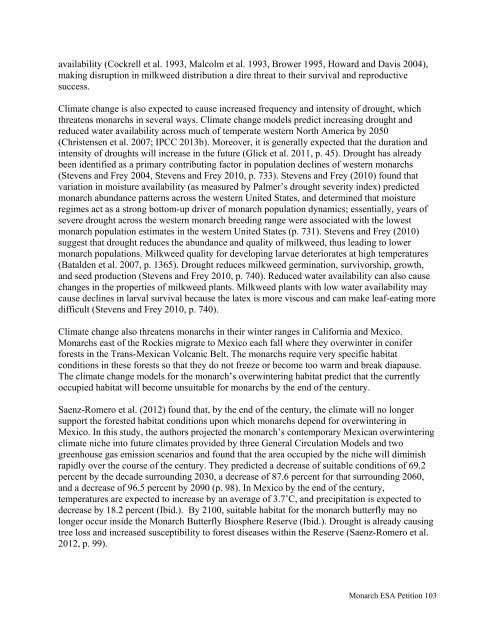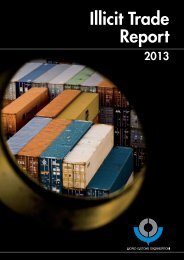monarch-esa-petition-final_61585
monarch-esa-petition-final_61585
monarch-esa-petition-final_61585
You also want an ePaper? Increase the reach of your titles
YUMPU automatically turns print PDFs into web optimized ePapers that Google loves.
availability (Cockrell et al. 1993, Malcolm et al. 1993, Brower 1995, Howard and Davis 2004),<br />
making disruption in milkweed distribution a dire threat to their survival and reproductive<br />
success.<br />
Climate change is also expected to cause increased frequency and intensity of drought, which<br />
threatens <strong>monarch</strong>s in several ways. Climate change models predict increasing drought and<br />
reduced water availability across much of temperate western North America by 2050<br />
(Christensen et al. 2007; IPCC 2013b). Moreover, it is generally expected that the duration and<br />
intensity of droughts will increase in the future (Glick et al. 2011, p. 45). Drought has already<br />
been identified as a primary contributing factor in population declines of western <strong>monarch</strong>s<br />
(Stevens and Frey 2004, Stevens and Frey 2010, p. 733). Stevens and Frey (2010) found that<br />
variation in moisture availability (as measured by Palmer’s drought severity index) predicted<br />
<strong>monarch</strong> abundance patterns across the western United States, and determined that moisture<br />
regimes act as a strong bottom-up driver of <strong>monarch</strong> population dynamics; essentially, years of<br />
severe drought across the western <strong>monarch</strong> breeding range were associated with the lowest<br />
<strong>monarch</strong> population estimates in the western United States (p. 731). Stevens and Frey (2010)<br />
suggest that drought reduces the abundance and quality of milkweed, thus leading to lower<br />
<strong>monarch</strong> populations. Milkweed quality for developing larvae deteriorates at high temperatures<br />
(Batalden et al. 2007, p. 1365). Drought reduces milkweed germination, survivorship, growth,<br />
and seed production (Stevens and Frey 2010, p. 740). Reduced water availability can also cause<br />
changes in the properties of milkweed plants. Milkweed plants with low water availability may<br />
cause declines in larval survival because the latex is more viscous and can make leaf-eating more<br />
difficult (Stevens and Frey 2010, p. 740).<br />
Climate change also threatens <strong>monarch</strong>s in their winter ranges in California and Mexico.<br />
Monarchs east of the Rockies migrate to Mexico each fall where they overwinter in conifer<br />
forests in the Trans-Mexican Volcanic Belt. The <strong>monarch</strong>s require very specific habitat<br />
conditions in these forests so that they do not freeze or become too warm and break diapause.<br />
The climate change models for the <strong>monarch</strong>’s overwintering habitat predict that the currently<br />
occupied habitat will become unsuitable for <strong>monarch</strong>s by the end of the century.<br />
Saenz-Romero et al. (2012) found that, by the end of the century, the climate will no longer<br />
support the forested habitat conditions upon which <strong>monarch</strong>s depend for overwintering in<br />
Mexico. In this study, the authors projected the <strong>monarch</strong>’s contemporary Mexican overwintering<br />
climate niche into future climates provided by three General Circulation Models and two<br />
greenhouse gas emission scenarios and found that the area occupied by the niche will diminish<br />
rapidly over the course of the century. They predicted a decrease of suitable conditions of 69.2<br />
percent by the decade surrounding 2030, a decrease of 87.6 percent for that surrounding 2060,<br />
and a decrease of 96.5 percent by 2090 (p. 98). In Mexico by the end of the century,<br />
temperatures are expected to increase by an average of 3.7˚C, and precipitation is expected to<br />
decrease by 18.2 percent (Ibid.). By 2100, suitable habitat for the <strong>monarch</strong> butterfly may no<br />
longer occur inside the Monarch Butterfly Biosphere Reserve (Ibid.). Drought is already causing<br />
tree loss and increased susceptibility to forest diseases within the Reserve (Saenz-Romero et al.<br />
2012, p. 99).<br />
Monarch ESA Petition 103




